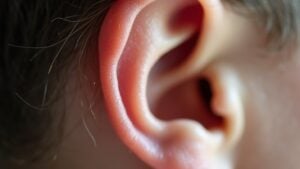Twitching above the ears can be unsettling, leaving many pondering what’s prompting the sudden, involuntary movements. This sensation, often linked to muscle spasms or nerve irritation, may stem from stress, fatigue, or even minor facial injuries. While typically harmless, persistent twitching could signal underlying issues worth exploring. Comprehending the triggers, symptoms, and time to seek assistance can ease concerns—and knowing the right steps could just bring relief sooner than anticipated.
Causes of Ear Area Twitching
While it could seem strange initially, twitching above the ears is actually more common than many people realize. One possible cause is hemifacial spasm, where the facial nerve becomes irritated, leading to twitches on one side of the face. This occurs when nearby blood vessels compress the cranial nerve, triggering involuntary contractions in the facial muscles.
Other causes include stress, fatigue, or excessive caffeine, which strain the nervous system and overstimulate muscles on one side. Minor injuries or swelling near the ear can also irritate nerves, resulting in spasms. Though symptoms of hemifacial spasm usually manifest gradually, sudden twitching might still happen. Comprehending these triggers helps recognize when twitches are harmless or necessitate medical attention, easing unnecessary worry.
Common Symptoms Associated With Preauricular Twitching
Preauricular twitching isn’t just about random muscle spasms—it often comes with other noticeable signs that help pinpoint what’s happening. Alongside the twitching near the ear, some people feel a pulling sensation or fullness in the area. The spasms can spread to nearby muscles, like the eyelid, cheek, or corner of the mouth, creating subtle but persistent movements.
Others report unusual sounds, such as clicking, buzzing, or ringing in the affected ear, which can be distracting or unsettling. Stress or fatigue might make these symptoms worse. While occasional twitching is usually harmless, persistent or worsening signs could indicate something deeper. Recognizing these accompanying symptoms helps in comprehension of whether the issue is minor or needs further attention.
Diagnostic Approaches for Facial Muscle Spasms
Because facial muscle spasms can be unsettling, getting the right diagnosis is key to finding relief. A thorough evaluation helps pinpoint the cause and guides an effective treatment plan, improving quality of life.
Neurological examination: Checks reflexes, muscle strength, and nerve function to identify irregularities.
Medical history: Reviews symptoms, triggers, and past health issues to narrow down potential causes.
Imaging tests (MRI/angiography): Detects blood vessel compression, tumors, or other structural problems affecting facial nerves.
Electromyography: Measures electrical activity in muscles to spot facial nerve lesions or dysfunction.
Comprehensive diagnosis: Combines findings to rule out other conditions and tailor a targeted approach.
Accurate diagnosis guarantees the right steps are taken to address the root cause, reducing discomfort and restoring normal function. Timely intervention often leads to better results.
Treatment Options for Involuntary Ear Twitching
Ear twitching, though usually harmless, can be frustrating as it happens often. For mild spasms caused by stress, simple relaxation techniques could help.
If the facial nerve near a blood vessel is compressed, Botox injections can temporarily relax the affected muscles, reducing the unwanted movement. Oral medications like muscle relaxants also calm overactive nerves.
For persistent hemifacial spasms, microvascular decompression surgery can relieve pressure on the facial nerve. In less severe cases, topical numbing creams or physical therapy exercises might provide relief by improving muscle control.
Each treatment targets the root cause differently, ensuring options exist for varied needs. Consulting a specialist helps determine the best approach, whether it’s medication, injections, or surgical decompression for long-term relief. Personalized plans maximize comfort and effectiveness.
When to Seek Medical Attention for Facial Twitches
- Hemifacial spasms that last weeks or worsen, often caused by pressure on the facial nerve or blood vessel irritation.
- Twitches paired with pain, weakness, or drooping on the side of the face, hinting at nerve damage.
- Spasms disrupting daily tasks or sleep, requiring treatment for hemifacial spasm like medication or therapy.
- Sudden onset with no clear trigger, warranting a neurologist’s evaluation.
- Recurring twitches spreading beyond the face, suggesting broader neurological concerns.
Early intervention can prevent complications, so don’t ignore persistent symptoms.
Conclusion
Twitching above the ears could seem harmless—until it isn’t. What begins as an occasional flutter may spiral into something more, leaving you questioning every blink and spasm. Is it simply stress, or is your body sounding an alarm? The answer lingers, concealed between frayed nerves and silent warnings. Only time—or a doctor’s keen eye—will disclose if it’s a fleeting nuisance or a sign whispering for attention.


